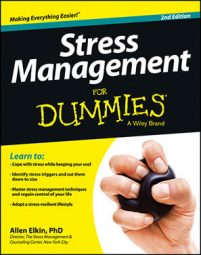Changing the way you breathe can make all the difference in how you feel and can alleviate stress within minutes. Sometimes, all it takes to make you feel better is one simple change. The following exercises present various ways to alter your breathing. Try them and discover whether all you need is one simple change.
Better breathing for starters
Here is one of the best and simplest ways of introducing yourself to stress-effective breathing.
Either lying or sitting comfortably, put one hand on your belly and the other hand on your chest.
Inhale through your nose, making sure that the hand on your belly rises and the hand on your chest moves hardly at all.
As you inhale slowly, count silently to three.
As you exhale through your parted lips slowly, count silently to four, feeling the hand on your belly falling gently.
Pause slightly before your next breath. Continue to breathe like this until you feel completely relaxed.
Take a complete Zen breath
Taking complete breaths (or doing Zen breathing, as it’s often called) helps you breathe more deeply and more efficiently and helps you maximize your lung capacity.
Lie comfortably on a bed, in a reclining chair, or on a rug.
Keep your knees slightly apart and slightly bent. Close your eyes if you like. You may feel more comfortable placing a pillow under the small of your back to help relieve the pressure.
Put one hand on your abdomen near your belly button and the other hand on your chest so that you follow the motion of your breathing.
Try to relax. Let go of any tension you may feel in your body.
Begin by slowly inhaling through your nose, first filling the lower part of your lungs, then the middle part of your chest, and then the upper part of your chest.
As you inhale, feel your diaphragm pushing down, gently extending your abdomen, making room for the newly inhaled air. Notice the hand on your abdomen rise slightly. The hand on your chest should move very little, and when it does, it should follow your abdomen. Don’t use your shoulders to help you breathe.
Exhale slowly through your parted lips, emptying your lungs from top to bottom.
Make a whooshing sound as the air passes through your lips, and notice the hand on your abdomen fall.
Pause slightly and take in another breath, repeating this cycle.
Continue breathing this way for ten minutes or so — certainly until you feel more relaxed and peaceful. Practice this technique daily if you can. Try this exercise while sitting and then while standing.
With a little practice, this form of breathing comes more naturally and automatically. With some time and some practice, you may begin to breathe this way much more of the time. Stick with it.
Try some “belly-button balloon” breathing
A simpler way of breathing more deeply and more evenly is to work with a visual image, in this case a balloon. Here’s what you do:
Imagine that a small balloon — about the size of a grapefruit — is replacing your stomach, just under your belly button, as shown in this figure.
![[Credit: Illustration by Pam Tanzey]](https://www.dummies.com/wp-content/uploads/382044.image0.jpg) Credit: Illustration by Pam Tanzey
Credit: Illustration by Pam TanzeyAs you inhale through your nose, imagine that you’re actually inhaling through your belly button, inflating this once-empty balloon.
This balloon is small, so don’t overinflate it. As the balloon gets larger, notice how your belly rises.
Exhale slowly through your nose or mouth, again imagining that the air is leaving through your belly button.
Your balloon is now slowly and easily returning to its deflated state.
Pause slightly before the next breath in and then repeat, gently and smoothly inflating your balloon to a comfortable size.
Repeat this exercise, as often as you can, whenever you can.
Stand up straight to alleviate stress
Your mother was right! When you’re under stress, you have a tendency to hunch over, making your posture lousy and your breathing impaired. You then breathe less deeply, denying your system the proper supply of oxygen you need. As a result, your muscles get tense. When you stand or sit straight, you reverse this process.
You needn’t stand like a West Point cadet to correct bad posture. Overdoing it probably produces as much tension as you felt before. Just keep your shoulders from slouching forward. If you’re unsure about what your posture looks like, ask your mother or a good friend.
How to breathe under stress
Breathing properly is no big deal when you’re lying on your bed or vegging out in front of the TV. But what’s your breathing like when you’re caught in gridlock, when you’re facing down a deadline, or when the stock market drops 20 percent? You’re now in crisis mode. You need another form of breathing. Here’s what to do:
Inhale slowly through your nostrils, taking in a very deep diaphragmatic breath, filling your lungs and filling your cheeks.
Hold that breath for about six seconds.
Exhale slowly through your slightly parted lips, releasing all the air in your lungs.
Pause at the end of this exhalation. Now take a few “normal” breaths.
Repeat Steps 1 through 3 two or three times and then return to what you were doing. This form of deep breathing should put you in a more relaxed state.

